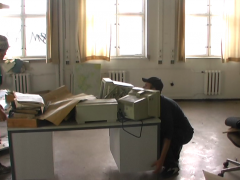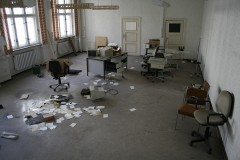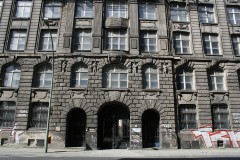Nicholas Vargelis is a visual artist working in various mediums. Nicholas' work combines various contemporary practices -- social organization, technological development, narrative histories, the iconography of forms (such as the history of the light bulb), with the artist as "situation inventor" who alters contexts to provoke different orders of thought. Nicholas' practice is often collaborative and is, above all, influenced by a social network of artists, writers, architects, designers and other thinkers.
contact : nvargelis [at] gmail . com
Video presentation : https://vimeo.com/576209352
Hotel Neptune centers on a text I wrote during my last visit to my grandparent's hotel and the fantoms of family conflict and trauma that resurfaced.
Growing up, I would visit my grandparents hotel-casino building every summer and every summer I would carefully take note of the physical changes to the structure of the building: doorways appear and disappear. Walls move. Windows became doors. Staircases change direction etc. And one summer a basement is dug under the building. Later, an adjacent building is bought and integrated into the hotel-casino complex with the addition of several passageways or thresholds. It was as if I was spending my childhood summers in a never ending Gordon Matta-Clark work, an architecture in constant surreal transformation. Or perhaps its a Greek-American version of Robert Smithson's "Hotel Palenque" trapped in a cycle of simultaneous decay and renovation.
This mise-en-scène sets the stage for a family drama that unfolds.















The other day, I went to La Réserve des Arts (a supply warehouse open only to artists). When I went to pay for the items I wanted, I had to renew my membership, and as the clerk asked for various administrative details he started with the seemingly absurd question, "Are you still an artist ?”. I make artistic work, but it seems that my job as an artist, in this context, is solely defined by my tax declarations with the French government or as a non-French artist, my status with a cultural institution, such as la Cité Internationale des Arts.
Building upon artist Lydia Eccles "The Days Of Our Lives [An Investigation of the Obvious]", I wish to shift the scope of investigation of time, work, and value to specially an art centered context by asking fellow artist here at the Cité des Arts and other artists here in Paris what is their daily relationship or experience of feeling labor/ time/ life.
When I first learned about the Cité Internationale des Arts I was impressed with the sheer size of the institution with over 300 artists in residency simultaneously. However I soon learned that we are not all here on similar terms. Different programs here at the Cité provide varying levels of funding to artists, while some artists are here without any funding and have to pay a fee for the use of the studio. Add to this the usual divisions of some artists having gallery representation (and support), versus the necessity for some of us to have a day job or others to be in a constant game of seeking out institutional funding. Also there is often the undisclosed means of subsistence: family wealth. And not to mention the disadvantage many non-European artists are dealt: an art education that costs an exorbitant amount of money resulting in bank loans that often leave the artist in debt for decades if not the rest of their life.
Are you clearly and precisely able to distinguish the time you own from the time you sell ? Do you differentiate "free time" from "work time"? How do you deal with nature in order to subsist? But can one disassemble a daily routine when the work of an artist and life of an artist tend to collapse into one? Have you ever been in a precarious state? Endless searches for real-estate, a sense of home, stability, etc. could be a springboard for a delirium of digressions.
Regardless of the means of entry into the Cité des Arts, all of us can claim this space as a refuge, even if it's just for a fleeting moment. During this sojourn there is the potential to think, to experiment, to express, to imagine, to invent, to meet, to traverse, and to share. An occasion to pause and maybe even a desire to go beyond the simple act of sheltering and instead construct a nest.
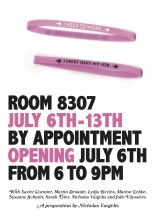

















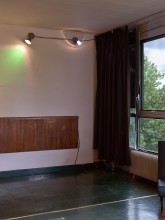

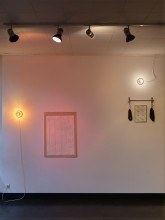


Partition walls and lighting control panels, “Mais où est l’infrastructure ?” is a performative work. With simple materials from French and American hardware stores, Nicholas Vargelis builds mobile partition structures that make visible the infrastructure, usually absorbed in the building. He thus plays with architecture of the exhibition space. Each wall unit features a lighting system with several electrical switches and dimmers to allow for variations of light.
The walls are designed to be easily moved. These mobile partition walls with their integrated lighting systems are conceived as a means to both display and illuminate art works from the collection “MULTIPLE” from the Centre National Edition Art et Image (Cneai= ), with works from Glen Baxter, Claude Closky, Koenraad Dedobbeleer, Peter Downsbrough, Yona Friedman, Thomas Hirschhorn, Vera Molnár, Michael Morley, and Leah Singer.
Link to video presentation :
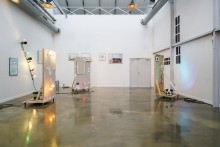


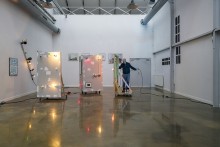


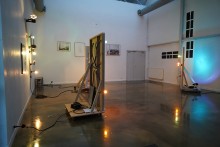

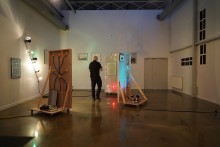











"Bright Colorful Lights and Other Attractions" takes the form of a lighting installation made especially for the presentation and performance of Nicholas' 'lighting review' of the 1983 film "Variety".
In Variety, set in a 1980s colored New York City, a woman starts working in a porn cinema. The film follows her as she becomes more and more obsessed with pornography. With a razor-sharp script by Kathy Acker and with Bette Gordon's background in structural cinema, Variety is a unique depiction of a young woman's emancipation in an archaic New York City. In Nicholas' text, he delves into how the cityscape and its various types of lighting illuminate the film and traces a narration of desire through the carnivalesque and theatrical use of available electric light sources employed in the making of the film.
Link to video presentation: 13,5 min :
Bright Colorful Lights and Other Attractions








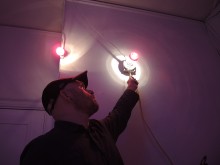











The Studio/Cinema or Kino/Atelier grows out of a desire to examine how the reception of a movie is conditioned to a greater or lesser extent by the environment in which it is shown. The program of this micro cinema centers on the collapsing of the projected image into an exotic architecture inter-spliced with live acts on a stage, something akin to a “cinema of attractions” or a carnivalesque atmosphere; otherwise known as a Cinema Palace where the built architecture of the space itself becomes the destination or raison d’être of “going to the movies.” However instead of offering a total experience of escape, the Studio/Cinema intentionally remains an unfinished or incomplete fragment.
The Studio/Cinema consists of an auditorium, stage, projection booth, concessions stand and marquee. The space is equipped with two 16mm film projectors, silver projection screen, sound system, cinema chairs, and a lighting system featuring various color washes illuminating not only the stage but also the projection screen, auditorium walls, projection booth and concessions stand.
For further reading please consult the "Studio/ Cinema Tour" text in the publication Kino/ Atelier - Program edited by Bauer Verlag, 2020, at Les Presses du Réel.



















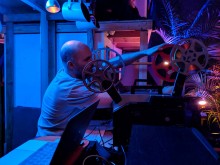
Relating different events that occurred when he worked with the artist group “Et al.*”, Nicholas’ performance combines real and alternative facts about a very personal story. He mentions in particular, lines of conflict when working in collaboration with a group: issues of collective creation, authorship and trust; all the while struggling to maintain a friendship corrupted by unbalanced power relations. These various stories and anecdotes of life with the artist group are intermixed with references to psychological pathologies (Stockholm Syndrome, Perversion, Narcissism, etc.) parallel to confessions and self critical reflections.
Starting off as a minimalistic light show operated onstage by Nicholas using common electric supplies, the performance continues as a slide show complemented by the artist’s eloquent yet intricate account of the challenges involved in collective artistic practice and the dynamics of his codependent relationship, intertwining public display and intimate self-disclosure.
Link to video :










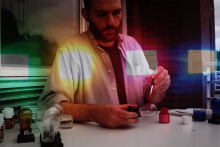




An exhibition of paintings by Zoë Wright and an installation of an electrical infrastructure by Nicholas Vargelis.
This show centers on Zoe and Nicholas' friendship that started in Paris many years ago when they met by chance as studio neighbors. Planning for this collaboration in NYC centered on reading and discussing texts on modernism and the position of the artist or author in a work without a beginning or an end. Preparations for the show took form in studio visits and regular rendez-vous at the café located half-way between their respective apartments in Ridgewood, Queens, New York. These discussions touched upon but never explicitly asked "what paintings will be show under which color of light ?, etc." Instead an implicit trust in each others work was affirmed by the absence of such pragmatic questions.



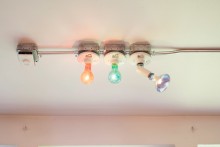
























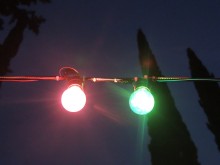
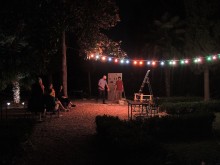







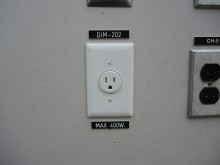


Augustin Grenèche, Sarah Tyler and Nicholas Vargelis make a functional cafeteria serving cheap gourmet food. The three collaborators perform the various roles of the cafeteria: a sausage cook, a vegan cook and an administrator/ cashier. The cafeteria presents the sausage menu and vegan menu as exclusive culinary paradigms in a colorful mise-en-scène realized with a dynamic lighting installation.
Through scripted roles, the three workers of the cafeteria interact with customers playing with coercion, implementing various rules, show of authority, control of bodies, distribution of food and the manipulation of atmosphere through electric light. Furthermore, the work embraces both the exploration of human relations and their social context, while at the same time also hints at a theatrical situation that follows pre-determined situations.









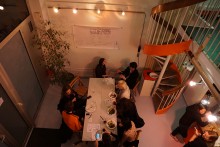




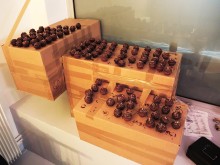


The French title “Jeux d’Eau” is translated as water jets or can be literally translated to mean water games. The installation consists of garden hoses and water sprinklers commonly found in suburban yards. The water jets of the installation form a variety of aesthetic patterns controlled by a central set of valves made accessible for one to play or control the varying constellations of water formations mimicking public fountain displays.
These different setting of the water displays are inspired by the 1953 experimental film "Eaux d'Artifice" by Kenneth Anger, featuring the fountains of an aristocratic garden in Italy.
Link to 30 sec. video documentation :


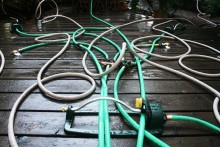




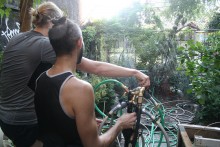




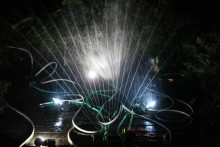
An often mis-quoted/ mis-translated sentence of Yves Klein is printed in vinyl letters and installed on a white wall: “La couleur est asservie par la ligne qui devient l’écrit d’une fausse réalité.” (Color is enslaved by line that becomes the writing of a false reality.)
During a brief performance, the vinyl sentence gets “egged.” Eggs filled with yellow paint are thrown at the sentence. The eggs and paint smash against the wall. Partially obstructed by the yellow paint, the quote can be read in a new way: “La couleur est asservie d’une fausse réalité..” (Color is enslaved by a false reality.)
To the right of the sentence three light switches control three different sets of lamps connected to an electrical track suspended from the ceiling. The three sets of lamps correspond to three different technologies: incandescent, fluorescent, and L.E.D. Using the three light switches one can light the sentence with the various lighting technologies revealing the aesthetic differences of what is considered “white” light.
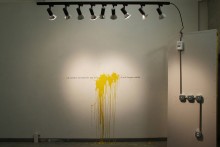
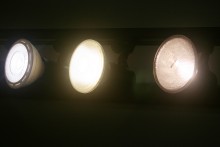







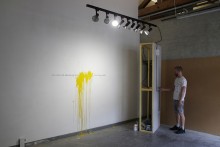




"(When Something's Good It’s Always Good)," Zine, 32 pages, 19 x 14 cm, 2015-2016, two color riso printing.
This zine is part travelogue and part critical essay. The text uses the electric filament light bulb as an instigator to elaborate on aesthetic and social phenomena.
The work was printed in two colors on a 1990's-era risograph printer. The design of the zine takes into account the limitations of this technology as a chance operation – specifically the near impossibility of calibrating the machine to adhere to the placement of the printed image on the page when using more than one color. Unlike with laser printing, riso inks are soy-based and slightly translucent allowing for colors to be overprinted.
Archive/ distribution :

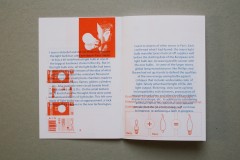



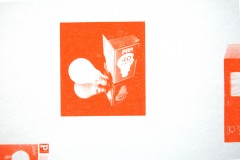

The artist group Et al.* worked with Colette Lumière (a.k.a. Colette Justine) to recreate her signature immersive environment at the Sunview Luncheonette. The Luncheonette is an old 1950’s diner frozen in time since it closed in the late 2000’s and is presently used as a project space. The diner is completely transformed or “Colettesized” through the use of pink silks and other fabrics. A special lighting installation is made that produces a very dim back- light from behind the many layers of fabric that emphasizes the materiality and layered nature of the work.
Parallel to the “Colettesization” of the Luncheonette, a scale model of the space is made entirely out of plexiglass, as a further symbolic transformation of the space. The uniform and angular plexiglass acts as an oppositional force to the installation of silks and pink fabrics. The scale model is displayed in an adjacent room draped in back curtains. In the center of this space, a single spotlight is focused on the display of the plexi-glass model.









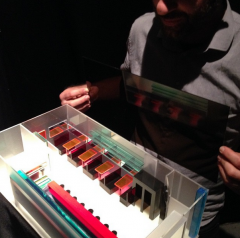

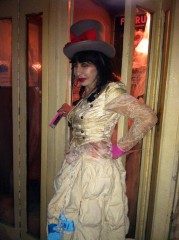

The Bradley Eros VHS archive (or the Velvet Hermetic System) is a collection of over 600 VHS tapes collected by Mr. Eros, a New York City experimental filmmaker. The archive is currently on long-term loan to the Sunview, a project space in Brooklyn. Most of the titles in the collection are from an underground culture of the 1980’s and 1990’s. While some tapes were obtained from various movie distribution houses, others are dubs and bootlegs.
As the collapse of the downtown movie houses gave rise to the suburban home theater, now in the 21st century the activity of movie viewing has moved online. With the personal computer attention moves at the speed of clicks. Rarities are decidedly more accessible. The immediacy of Youtube, Karagarga and UbuWeb have disappeared embodied searching. The archive contains a holy grail of weirdness and subversive art collected while Eros lived in Chinatown and the East Village in the 80s and Williamsburg during the 90s.






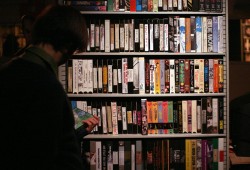
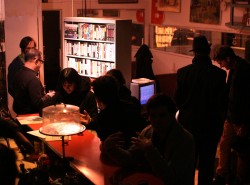

This work consists of two parts: First, a video loop documenting the artist stealing light bulbs in the streets of Paris, turning off the lights in Parisian métro, activating the visible parts of a circuit in the artist’s studio, and the artist installing (in a clandestine manner) hand painted light bulbs in a European art institution . Second: a sculpture made of standard modular lighting parts and light bulbs gathered, bought, or illicitly obtained from diverse locales such as the flea market , various art institutions, various rendez-vous via LeBonCoin.fr, S.B.F. Electricité, etc.
Video can be viewed via this web page:





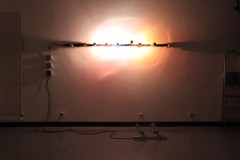




For this installation, an electrical system is installed consisting of outlets, switches, and black cable. On the floor is a box of hand painted incandescent light bulbs of various colors and forms plus a box of electrical cables with sockets and plugs that work in conjunction with the outlets installed in the ceiling and the hand painted light bulbs.
During the opening of the show the artist uses these materials to execute a dynamic lighting situation. Following a script, he manipulates the lamps and creates varying arrangements of color, intensity, focus, direction, and position.
The artist also sits behind a small stand offering visitors to buy a copy of Light Requisite for an Electric Stage in the form of a cheap plastic silver-glitter hats. The title given to the sparkle-hat is referencing the kinetic light sculpture by Laszlo Moholy-Nagy of the same name built between 1922 and 1930.
In this installation the kinetic sculpture of Moholy-Nagy is replaced by the cheap plastic sparkle hats, and Moholy-Nagy’s lighting effects -- executed by programable relay switches and machines -- are instead executed with the action of the body of the artist and the bodies of the visitors in the gallery.
For video documentation please consult the following link:



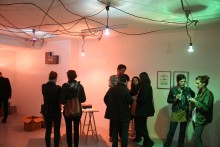






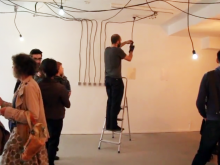









Part lecture and part installation, This work highlights the aesthetic variations of incandescent lighting technology.
The lecture happens under a scenography of colorful gallery track lighting activated in a theatrical way. The abrupt lighting changes occur in contrast to the rhythm of the lecture.
After the lecture, the public is invited to have a glass of champaign in a fictitious light bulb store, celebrating a “Grand Opening”. A gigantic wooden sculpture “When Something’s Good, It’s Always Good,” is again used. This time the sculpture is re-built in a larger scale and light bulbs are added. Blaring carnivalesque music fills the room.
Just below the sign, is a big bin displaying the light bulbs for sale. People are invited to select light bulbs from the bin and present them to the light bulb salesman. After observing how each light bulb works in the light bulb tester, the customer can then buy the light bulb for less then its market value.



















During the conception of this work, the ban on incandescent light bulbs in Europe had already started. Notably all frosted incandescent light bulbs had been taken out of production and off the market.
In order to engage people and provoke a conversation or an exchange, several hundred incandescent light bulbs are given away for free, in front of the the Cité Internationale Université de Paris, a busy student center in the south of Paris. The light bulbs have a frost or matt finish applied to the glass surface with a paint brush. To create the light bulb stand an art work from friend and colleague Augustin Grenèche is appropriated that consists of a sentence written with giant wooden letters, “When Something’s Good It’s Always good.”
Over the course of an afternoon, hundreds of light bulbs are given away and countless engaged conversations are had with various people passing by on topics ranging from economy, ecology, aesthetics, health, nuclear energy, globalization, consumer freedom, and planned obsolescence.






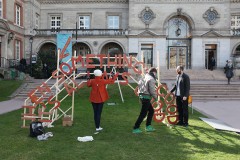

At the art school of Cergy, arrangements are made to have the school cafeteria closed, and a competing cafeteria is made in one of the gallery spaces. The new cafeteria sells vegan soup, cartons of orange juice, and boxes of cigarettes at below market value. The workers of this new business are all foreigners and only communicate in their native languages (German and Spanish). Big wall text in red letters spells out “vegan solidarity” in English, German, French, and Russian. Across from the big pot of soup, a small radio dangling from a nail in the wall plays a song of the Béruriers Noirs (French Anarchist- Punk group from the early 1980’s) in a never ending loop. Close to the radio, a piece of A4 paper is glued to the wall with a text from an interview with Theodor Adorno on politically engaged popular music.





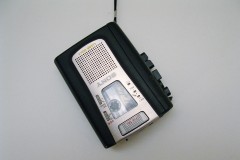

This project uses the cupcake, an iconic American dessert item turned vegan, as an instigator for staging transformations of space and accessibility.
On the first day of the installation, a pyramid is erected to display over 1,000 vegan cupcakes, and people are invited to eat the cupcakes, self-service. But some people are aggressive and greedy taking too many cupcakes.
On the second day, a new system featuring a wall and an administrative desk is constructed. Another 1,000 cupcakes arrive. To get a cupcake, one must fill out a simple form answering: “veganism: define.” All forms are validated no matter what the answer is. One form grants the right to one cupcake. Some people do not like this and cupcakes are stolen.
For the third day, a “chateau fort” is constructed to protect a new set of approximately 1,000 vegan cupcakes. In order to eat a cupcake, one has to make an application for a cupcake. All applications are evaluated and judged individually. However the protocols of judgment change suddenly and without warning. A validated application grants access to one or more cupcakes.
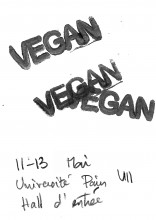



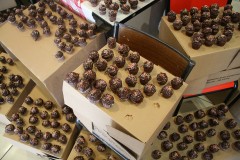




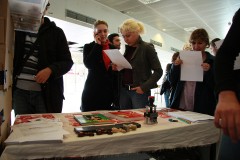




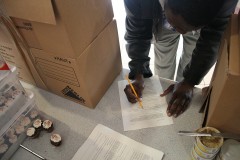







This project took place in the abandoned East German Train headquarters. For two weeks my collaborator and I worked inside the building, meticulously moving the contents of one office- everything from desk to chairs to documents- through 40 empty office rooms, one by one...
The building was not open to the public, and each day we illicitly gained entry through a series of tunnels under the adjacent elevated train tracks. Our audience consisted of a team of security guards of whom we carefully avoided.
We photographed the rooms as they were: empty, then full, then empty again. Next in each empty room that the office objects had passed through, we pasted a photo on the floor depicting the same room, but full of the office furnishings and objects.


